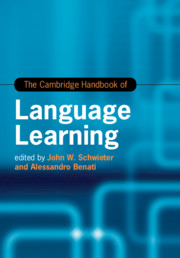Book contents
- The Cambridge Handbook of Language Learning
- Cambridge Handbooks in Language and Linguistics
- The Cambridge Handbook of Language Learning
- Copyright page
- Contents
- Figures
- Tables
- Contributors
- Acknowledgements
- Introduction
- Part I Theories
- Part II Methods
- 5 Qualitative Classroom Methods
- 6 Experimental Studies in L2 Classrooms
- 7 Action Research: Developments, Characteristics, and Future Directions
- 8 Classroom Observation Research
- 9 Psycholinguistic and Neurolinguistic Methods
- Part III Skill Development
- Part IV Individual Differences
- Part V Pedagogical Interventions and Approaches
- Part VI Context and Environment
- Part VII Moving Forward
- Index
- References
7 - Action Research: Developments, Characteristics, and Future Directions
from Part II - Methods
Published online by Cambridge University Press: 25 June 2019
- The Cambridge Handbook of Language Learning
- Cambridge Handbooks in Language and Linguistics
- The Cambridge Handbook of Language Learning
- Copyright page
- Contents
- Figures
- Tables
- Contributors
- Acknowledgements
- Introduction
- Part I Theories
- Part II Methods
- 5 Qualitative Classroom Methods
- 6 Experimental Studies in L2 Classrooms
- 7 Action Research: Developments, Characteristics, and Future Directions
- 8 Classroom Observation Research
- 9 Psycholinguistic and Neurolinguistic Methods
- Part III Skill Development
- Part IV Individual Differences
- Part V Pedagogical Interventions and Approaches
- Part VI Context and Environment
- Part VII Moving Forward
- Index
- References
Summary
Action research has become increasingly prevalent in the field of English language teaching over the last two decades. It can be considered as a form of professional learning for language teachers which takes a socio-constructivist approach in which teachers are seen as agentive actors and investigators within their own social contexts. This chapter begins by providing a brief overview of the origins of action research and its development in the field of English language teaching, considering also some of the more recent initiatives that have contributed to the spread of this form of research in the field. It then discusses what various recent studies have shown about the impact on teachers of conducting action research. The discussion ends with a brief consideration of future directions for this research.
- Type
- Chapter
- Information
- The Cambridge Handbook of Language Learning , pp. 166 - 185Publisher: Cambridge University PressPrint publication year: 2019
References
- 10
- Cited by



